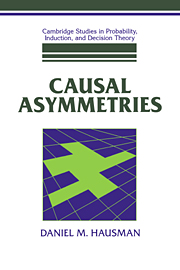Book contents
- Frontmatter
- Contents
- List of Figures
- Acknowledgments
- Introduction: Causation and its Asymmetries
- 1 Metaphysical Pictures and Wishes
- 1* Transfer Theories
- 2 Is Causation a Relation Among Events?
- 3 Causation, Regularities, and Time: Hume's Theory
- 4 Causation and Independence
- 4* Causation, Independence, and Causal Connection
- 5 Agency Theory
- 5* Causal Generalizations and Agency
- 6 The Counterfactual Theory
- 6* Independence and Counterfactual Dependence
- 7 Counterfactuals, Agency, and Independence
- 7* Agency, Counterfactuals, and Independence
- 8 Causation, Explanation, and Laws
- 8* Causation, Explanation, and Independent Alterability
- 9 Probabilistic Causation
- 10 Causation and Conditional Probabilities
- 10* Causal Graphs and Conditional Probabilistic Dependencies
- 11 Intervention, Robustness, and Probabilistic Dependence
- 11* Interventions and Conditional Probabilities
- 12 Operationalizing and Revising the Independence Theory
- 12* Probability Distributions and Causation
- 13 Complications and Conclusions
- Appendix A Alphabetical List of Propositions
- Appendix B List of Theorems
- References
- Index
1* - Transfer Theories
Published online by Cambridge University Press: 20 April 2010
- Frontmatter
- Contents
- List of Figures
- Acknowledgments
- Introduction: Causation and its Asymmetries
- 1 Metaphysical Pictures and Wishes
- 1* Transfer Theories
- 2 Is Causation a Relation Among Events?
- 3 Causation, Regularities, and Time: Hume's Theory
- 4 Causation and Independence
- 4* Causation, Independence, and Causal Connection
- 5 Agency Theory
- 5* Causal Generalizations and Agency
- 6 The Counterfactual Theory
- 6* Independence and Counterfactual Dependence
- 7 Counterfactuals, Agency, and Independence
- 7* Agency, Counterfactuals, and Independence
- 8 Causation, Explanation, and Laws
- 8* Causation, Explanation, and Independent Alterability
- 9 Probabilistic Causation
- 10 Causation and Conditional Probabilities
- 10* Causal Graphs and Conditional Probabilistic Dependencies
- 11 Intervention, Robustness, and Probabilistic Dependence
- 11* Interventions and Conditional Probabilities
- 12 Operationalizing and Revising the Independence Theory
- 12* Probability Distributions and Causation
- 13 Complications and Conclusions
- Appendix A Alphabetical List of Propositions
- Appendix B List of Theorems
- References
- Index
Summary
To provide a better sense of my picture and wishes, I shall discuss one recent theory of causation that fits my picture without satisfying my wishes. This is the so-called transference theory of causation presented and defended in the works of Aronson (1971a,b), Braddon-Mitchell (1993), Byerly (1979), Castaneda(1980, 1984), Dowe (1992a,b, 1995, 1996), Fair (1979), and Salmon (1994). In Jerrold Aronson's formulation, causes transfer some quantity (“e.g. velocity, momentum, kinetic energy, heat, etc.”) to their effects through contact (1971a, p. 422). In David Fair's formulation, causation “is a physically-specifiable relation of energy-momentum flow from the objects comprising cause to those comprising effect” (1979, p. 220). According to Hector-Neri Castaneda, something in need of specification, which he calls “causity,” is transferred. More recently Phil Dowe and Wesley Salmon describe causal interactions as intersections of causal processes that involve an exchange of some conserved quantity. Thus, for example, rolling billiard balls are causal processes, and their collisions (which involve an exchange of momentum) are causal interactions. I shall focus on Salmon and Dowe's version of a transfer theory.
Transfer theories fill in my picture of causation. They portray causation as fully objective. “Out there” world lines intersect, and there are exchanges of conserved quantities in some of these intersections. The study of causation, as the study of exchanges of conserved quantities, is a part of physics. In developing the notions of causal processes and causal interactions, Salmon and Dowe modify my naive ontology of substances and events; but they preserve the basic idea that causes and effects are things extended in time.
- Type
- Chapter
- Information
- Causal Asymmetries , pp. 13 - 17Publisher: Cambridge University PressPrint publication year: 1998

